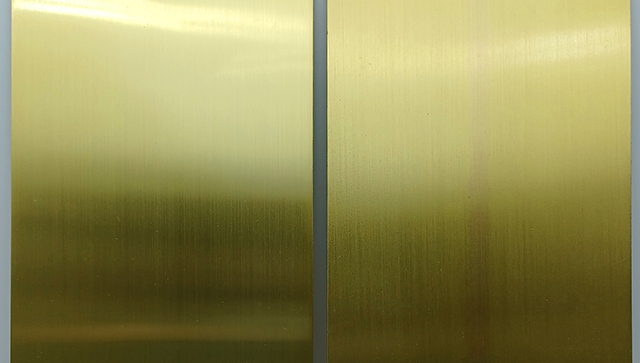June 17, 2022
Discolouration-Free Copper alloy C2600 Laser Welding
KIKUKAWA Succeeds in Discolouration-Free Copper alloy C2600 Laser Welding
A New Welding Method from our Technology Development Team
KIKUKAWA, a bespoke metal architect for interiors and exteriors, has achieved copper alloy C2600 laser welding with minimal heat discolouration.
Discolouration by welding of C2600 copper alloy has been a challenging issue. We have developed a new welding method to resolve this challenge, by adjusting the welding wire composition used at the welded parts joints, as well as the laser welding output. As a result, we are now able to minimise welding discolouration.
We used a colorimeter to compare the colours of the base metal and welded joints using our new welding method. The results showed that the colour difference was ΔE 0.81 (a colour matching degree of 91.6%). This represents a colour difference of less than a third of that arising from conventional TIG welding methods.

■ KIKUKAWA- Development of Welding Technology
At KIKUKAWA, we have a Technology Development Team in place, tasked with looking at how we can use cutting-edge technology such as laser welding in our products. The team spent three years testing and analysing the issue of welding discoloration on copper alloys. They were able to identify changes in copper composition ratios, caused by welding heat, as the cause of discoloration. After examining and testing various potential solutions, the team eventually succeeded in developing a laser welding technique that results in minimal discolouration.
■ Future outlook
This new welding technology enables us to offer our clients feasible fabrication methods where welding is required on finished surfaces. We will continue to focus on responding to client demands through our ongoing technology development. We are committed to exploring all possibilities in metal processing as a world-leading metalwork company.
*Brass: An alloy composed of 60-70% copper and 30-40% zinc. In this instance, we used C2600 as the base material, which is closer to gold in colour.
** ΔE (Delta E): A numerical value indicating the difference between two colours according to the distance between them in colour space. A value of ΔE 0.8—1.6, is said to represent a level where high colour accuracy is achieved and only a very slight difference is perceived with adjacent colours. At KIKUKAWA, we set a high standard with our in-house inspections requiring a value of ΔE 1.0 or less.


